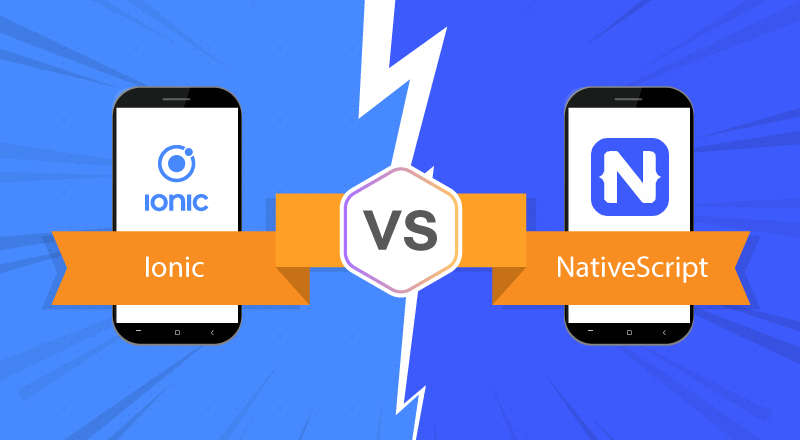
Ionic and React Native are two highly used tools in the sector of web and mobile app development. These tools serve as a great alternative to the native tools.
Developers are mostly confused about which platform to choose for their enterprise app development. The best thing about going with the mentioned tools is simplicity. You will use Javascript instead of Swift, Objective-C, Java, or Kotlin. This makes the job simpler as it reduces the learning effort. You can work for both platforms conveniently. So, let us know more about them.
What is Ionic 4?
Ionic is a complete open-source SDK developed for hybrid mobile applications. It was created back in 2013. It has tools and services that allow the development of hybrid mobile apps with the use of technologies like CSS, HTML5, and Sass. The developed apps can be distributed through native app stores that can be installed on devices.
Indigenously, for Android apps, Java is used for coding and Obj-C or Swift for iOS apps. These complex languages are warded off with the use of Ionic or Cordova by using the single code. You are good to run the same on Android, iOS, and even windows. All of this can be done with the use of simple HTML, CSS, and JS.
What is React Native?
React Native is a Javascript framework that is used to develop natively rendering mobile applications. This can be used for both iOS and Android. React Native is based on React, Facebook’s JavaScript library for building user interfaces. It is used to target mobile platforms. It allows the developer to write codes that feel completely native and is easy to write. Additionally, this can be shared between platforms, React Native makes it easy to simultaneously develop for both Android and iOS.
This tool is now supported only on iOS and Android, but seems to have a scope of being extended over platforms in the future.
It is a popular debate between the topics of Hybrid Mobile Apps and Native Apps. Native apps are platform-specific while hybrid apps mostly use web technologies. Native apps use the Cordova platform for better experience and access to native features.
While you choose the best tool for your work, these are the parameters you might want to take into consideration.
The Language Stack
React Native used Javascript, which is one of the most popular programming languages today. React Native uses JS along with React JS, backed by Facebook which is an advantage. Additionally, it also allows writing components in Swift, Objective-C, or Java when the requirement arises. The use of native modules and libraries in React Native applications makes management of heavy operations such as video handling or image editing.
Ionic framework, on the other hand, uses, HTML5, CSS, and JS develop and run applications. However, it also uses Cordova to access native platform controllers. Developers can also use TypeScript to code.
React Native v/s Ionic: React Native
Do not repeat yourself (DRY)
Ionic has great code reusability with the concept of “wrapped web app”. The adaptive components in the component library hold great use of the applications.
React Native only has a basic set of components that the programmer is allowed to start with. Most of the work is to be done on your own, unlike the component library in Ionic. It takes more effort to bring styles for different platforms.
React Native v/s Ionic: Ionic
Rich pre-styled Component Library
As you know, Ionic has its own component library, it already has a huge set of styles. The native app generated from toolchain is also a part of Ionic package with the ability to handle packages like Cordova or Capacitor. The components are adaptive and hence can run on any platform without putting a lot of burden on the developer.
While in React Native you can use a set of inbuilt components, but you would still have to handle the styles on your own. Also, the code is non-adaptive, making it difficult for cross-platform designs. This requires a different set of styling for different platforms, i.e., Android or iOS.
React Native v/s Ionic: Ionic
Performance
React Native renders code elements that are specific to the native API which is quite similar to the native apps. Developers can also use native modules for better performance. There is, however, a limitation to cross-platform use.
Ionic’s performance is not the same as React Native. The approach of using web technologies, decrease performance by decreasing the rendering speed. Also, it does not use any native modules. However, it is good for testing purposes.
React Native v/s Ionic: React Native
User Interface
React Native association with native modules and the utilization of the React JS library gives commendable user experience. It allows better UI development that is close to native apps.
Ionic doesn’t make use of native modules and rather applies Cordova for the same.
React Native v/s Ionic: React Native
Third-Party Libraries
Ionic uses Javascript and also supports Angular. You benefit from all the technologies tagged along.
React Native also uses JavaScript and React, hence you have got all of it. React Native has its own a vibrant ecosystem and community and hence you can take advantage of it. However, the downside to this is the dependence on core features.
React Native v/s Ionic: Ionic
Market and Community
React Native tops the list for this constraint. The network has been already large and is also growing. It makes development easy and real natives are developed. Overall, these features make it popular.
Ionic follows React Native in the development community. This makes development faster. It also has a great community where you can find a lot of support.
React Native v/s Ionic: React Native
Accessing Native Device Features
Ionic uses Cordova and capacitor to allow access to native device features. It gives access to common native device functionalities like the camera. You can also write your custom wrappers to include in your code. Along with this, the updates are mostly stable.
React Native, is the most popular due to its set of third-party packages and built-in APIs for accessing native functionalities. The support on the third-party apps can be difficult though that is not equal to Ionic or Nativescript.
React Native v/s Ionic: React Native
Supported Platforms
React Native is supported by Android 4. 1+, iOS 8+ and Ionic supported by Android 4. 4+, iOS 8+, Windows 10. The choice is pretty clear in this case.
Popular Apps
The popular apps associated with React Native are Facebook, Instagram, UberEats, Airbnb(formerly), and that with Ionic are JustWatch, Pacifica, Nationwide, and many more.
Pricing
React Native has free libraries and is completely open-source. It is a good source for developers to work with.
Ionic is also free to use for cross-platform developers, but also comes with a paid pro version.
Maintainability
Taking into consideration the third-party libraries associated with React native, maintainability is a huge block in the path. This is because the library might get outdated or incompatible.
Ionic makes the work easier as you need to maintain only one single app. However, the challenge is handling the continuous changes with frequent release cycles on Ionic and Cordova.
Your priorities and options are pretty clear if you have given this a read. If you require to build high performing apps that are close to native apps, you might choose to work with React Native over Ionic. While, if you need to build a decent performing app which will be an illusion to the users as a native app, you can go ahead with Ionic. However, it is all dependant on your preferences and the requirement of your project.
Also Read: How To Create Your First Flutter App?







Leave a Reply